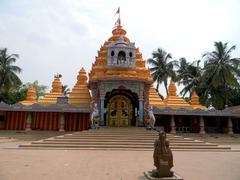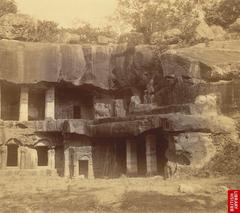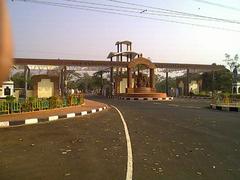Akhadachandi Temple: Complete Visitor Guide, History, Hours, Tickets, and Bhubaneswar Heritage
Date: 04/07/2025
Introduction
Akhadachandi Temple is a cherished spiritual and cultural landmark in Bhubaneswar, Odisha. Renowned for its distinctive Kalinga architecture and deep-rooted traditions, the temple is dedicated to Goddess Chandi—an embodiment of strength and protection. With a legacy spanning over a millennium, Akhadachandi Temple offers a unique blend of architectural elegance, vibrant festivals, and living religious practices. This comprehensive guide presents a detailed overview of its history, architecture, rituals, visitor information, and its place within Bhubaneswar’s dynamic temple circuit.
For further details and updates, consult official tourism resources and respected cultural blogs (omastrology.com, Pathbeat, Wanderlog).
Table of Contents
- Introduction
- Historical Background
- Mythological and Religious Associations
- Architectural Features
- Visiting Information: Hours, Tickets, Accessibility
- Festivals and Rituals
- Practical Visitor Tips
- Preservation Efforts and Community Role
- Integration into Bhubaneswar’s Tourism Circuit
- FAQs
- Conclusion
- References
Historical Background
Origins and Patronage
Akhadachandi Temple was built in the 10th century AD, during a flourishing era for temple construction in Odisha. Commissioned by local rulers devoted to Mahisasuramardini—Goddess Durga in her demon-slaying form—the temple stands as a testament to the region’s deep-rooted spiritual and architectural traditions (omastrology.com).
Mythological and Religious Associations
The temple’s presiding deity, Mahisasuramardini, represents the cosmic feminine power (Adi-Shakti) and the eternal victory of good over evil. Rituals and iconography emphasize her protective and martial attributes. Historical practices such as animal sacrifice, now largely symbolic, underscore the temple’s ancient roots in tantric and Vedic traditions.
Architectural Features
Kalinga Style and Khakhara Plan
Akhadachandi Temple embodies the Kalinga architectural style, famous for its curvilinear spires and ornate details. The temple follows the Khakhara plan—a rectangular structure with a distinctive semicircular roof. Though modest in size (approximately 1.28 by 1.83 meters), it is rich in symbolism and craftsmanship (omastrology.com).
Key Elements
- Orientation: The temple faces south, while the idol faces east, aligning with traditional auspicious directions.
- Vimana/Tower: Rising to 42.94 meters, the vimana symbolizes the cosmic axis.
- Material: Constructed from coarse-grained sandstone, showcasing the era’s engineering skills.
- Elevation: Divided into bada (base), gandi (body with semicircular roof), and mastaka (head, crowned with a kalasa and elephant motifs).
- Entrances: Three doorways allow for ritual movement; doorjambs are the main decorative feature.
Sanctum and Idol
The sanctum (garbhagriha) houses the east-facing idol of Mahisasuramardini, adorned with offerings and revered through daily rituals. The space is intimate and minimally ornamented, focusing the devotee’s attention on worship.
Visiting Information
Hours and Entry
- Open: Daily, 6:00 AM – 8:00 PM (some sources note closure at 8:30 or 9:00 PM on festival days).
- Entry: Free for all visitors.
- Best Time to Visit: Early mornings and late afternoons for a peaceful experience; festivals for vibrant celebrations.
Accessibility
- Wheelchair Access: Ramps and smooth pathways enable access for differently-abled visitors.
- Location: Centrally located in Bhubaneswar, near Bindusagar tank and other major temples.
Getting There
- By Air: Biju Patnaik International Airport (~5 km away).
- By Train: Bhubaneswar Railway Station (~3 km away).
- Local Transport: Auto-rickshaws, taxis, and app-based cabs are readily available.
Facilities
- Amenities: Drinking water, clean restrooms, shaded waiting areas.
- Guided Tours: Available via local agencies or temple office, offering historical and cultural context.
- Photography: Permitted in temple grounds (no flash during rituals); not allowed inside the sanctum.
Festivals and Rituals
Major Festivals
- Navaratri: Celebrated twice a year (Chaitra and Sharad), featuring nine days of puja, chanting, and cultural performances.
- Chandi Yatra: Unique to Goddess Chandi temples, includes ceremonial processions and traditional music.
- Durga Puja: Major festival with elaborate decorations and performances.
- Other Festivals: Makar Sankranti, Chaitra Parba, Durgastami, and monthly Sankrantis.
(Chirag Daruwalla’s festival list)
Ritual Practices
- Daily Schedule: Mangala Arati at dawn, Abhisheka (ritual bathing), Alankara (decoration), Naivedya (food offerings), and Sandhya Arati at dusk.
- Community Rituals: Homa (fire sacrifice), Annadanam (community feast), and Kumari Puja during Navaratri.
- Offerings: Devotees present coconuts, flowers, and sweets; prasad is distributed after rituals.
Practical Visitor Tips
- Dress Code: Modest attire required; remove shoes before entry.
- Behavior: Maintain silence, respect rituals, and keep phones on silent.
- Local Customs: Purchase offerings from nearby vendors; small donations are appreciated.
- Best Experience: Attend during festivals for cultural immersion; visit on weekdays for tranquility.
- Sustainability: Dispose of waste responsibly and support local artisans.
Preservation Efforts and Community Role
Akhadachandi Temple is actively maintained by the Bhubaneswar Municipal Corporation and Odisha State Archaeology. Restoration initiatives support the conservation of its unique sandstone structure and artwork. The temple is a focal point for community service—hosting free meals, health camps, and heritage education workshops. Local residents, priests, and volunteers ensure the temple remains a living spiritual and cultural center (Bhubaneswar Municipal Corporation).
Integration into Bhubaneswar’s Tourism Circuit
As part of Bhubaneswar’s renowned temple circuit, Akhadachandi Temple offers a peaceful, authentic alternative to busier landmarks like Lingaraj and Mukteshwar temples. It is featured in heritage trails and eco-cultural tours, providing a holistic experience of Odisha’s spiritual and architectural diversity (Pathbeat).
Nearby attractions include:
- Lingaraj Temple: 2 km away.
- Mukteshwar Temple: 1.5 km away.
- Udayagiri and Khandagiri Caves: 5 km away.
- Local markets: Ideal for exploring Odia handicrafts and cuisine.
Frequently Asked Questions (FAQ)
Q: What are the visiting hours of Akhadachandi Temple?
A: Open daily from 6:00 AM to 8:00 PM (check for festival day extensions).
Q: Is there an entry fee?
A: No, entry is free.
Q: Are guided tours available?
A: Yes, through local operators or the temple office.
Q: Is the temple accessible for wheelchair users?
A: Yes, with ramps and accessible pathways.
Q: When are the major festivals celebrated?
A: Navaratri, Durga Puja, and Chandi Yatra are the main festivals.
Q: Can I take photographs?
A: Yes, outside the sanctum; avoid flash and seek permission during rituals.
Conclusion
Akhadachandi Temple stands as a symbol of Odisha’s enduring spiritual heritage and architectural distinction. Its south-facing orientation, intimate sanctum, and vibrant festival calendar make it an essential destination for spiritual seekers, history enthusiasts, and cultural travelers. Thoughtful preservation, community involvement, and integration with Bhubaneswar’s broader temple network ensure its continued relevance as a living monument. For a truly enriching experience, plan your visit during major festivals or serene early morning hours, engage respectfully with local customs, and explore the surrounding historical sites.
Stay updated on visiting hours, festivals, and guided tours by downloading the Audiala app, exploring official Odisha tourism resources, or visiting trusted cultural blogs (omastrology.com, Pathbeat, Wanderlog).
References and Further Reading
- Akhadachandi Temple Bhubaneswar: History, Architecture, Visiting Hours & Travel Tips, 2025, OmAstrology
- Akhadachandi Temple Bhubaneswar: Visiting Hours, Tickets, History & Cultural Guide, 2025, Pathbeat
- Festivals, Rituals, and Visitor Experience at Akhadachandi Temple, Bhubaneswar: Visiting Hours, Tickets, and More, 2025, Wanderlog
- Akhadachandi Temple Bhubaneswar: Visiting Hours, Tickets, and Cultural Significance, 2025, Bhubaneswar Municipal Corporation
- Chirag Daruwalla Festival List
- Odisha Tourism Official Website
Information is accurate as of July 2025. All sources are provided in markdown format.








